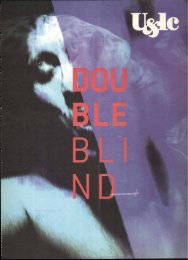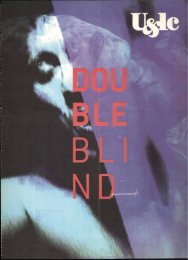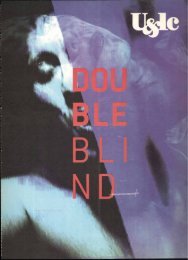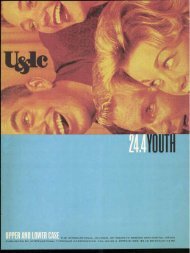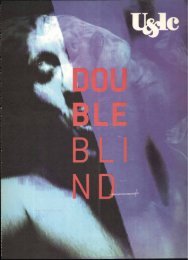Create successful ePaper yourself
Turn your PDF publications into a flip-book with our unique Google optimized e-Paper software.
A SEMIOTIC SYMBIOSIS<br />
JUMP-CUT, 199?<br />
Imagine the Internet.<br />
1.5 billion miles of spun glass and copper linking 173 million PCs running quadrillions<br />
of lines of code as quintillions of blips on silicon wafers. How many computations can<br />
dance on the head of a pin? A vast chain of hotlinks.<br />
In his book Mervelous Signals, Eugene Vance writes that "there is scarcely a term,<br />
practice, or concept in contemporary theory that does not have some rich antecedent<br />
medieval thought' This observation seems to apply particularly well in the case<br />
of collaboration between graphic designers and writers. The book, especially the<br />
Medieval book, is a profound virtual-reality device. The image/text, the contempo-<br />
rary reincarnation of illuminated texts, is simply a foregrounding of this multi-<br />
media nature that is original not in our sense of the word, but in the Medieval<br />
sense: that which has been present since the Origin.<br />
t. That is, literature too, has a material history and it is bound up with the history<br />
of the book which is a story of reproducibility and portability. Consider its end<br />
points: the cave painting, a one-of-a-kind, permanently bound to the most inac-<br />
cessible parts of the earth. Contrast this to the Amiens Cathedral (http://www .<br />
1<br />
* learn.columbia.edu ), an online "book" on the cathedral's history and art in which<br />
criticism, primary texts, floor plans, Quicktime movies and a discussion group<br />
can be made present—from anywhere in the world.<br />
Now consider the history between these end points: first the codex, the book<br />
in the shape of a box as opposed to scrolls like one manuscript of the Pentateuch,<br />
written on 57 skins sewn together to form a piece 36 meters long—a serial<br />
retrieval system which one reads by rolling from one scroll to another, like a<br />
cassette tape. With the parallel retrieval system of the codex, though, it's as<br />
easy to flip to page 200 as 20 and back; it is easy to begin to think what we<br />
would call hypertextually. Germane here is the truism that Medievals, like us,<br />
thought in terms of symbols. In a codex like the Moralized Bible, images linked<br />
texts to other texts, the Old Testament to the New. Psalm 80, for example, a<br />
prayer for the restoration of the Lord's Vineyard (Israel) prefigures Christ<br />
and this teleology is taught by a crucifixion posture of both grapes and man.<br />
Pushed to an extreme in the 20th century, it's easy to see what this type of<br />
thinking will do for traditional boundaries: man/machine; history/fiction;<br />
high art/popular entertainment; male/female; truth/image; private/public;<br />
original/copy; mind/body; text/image. Once again, stories and images are<br />
linked to others with the result that, as for Medievals, representation is sus-<br />
pect, for it is partial. The veil that separates us from?—<br />
Today, the re-patterning of knowledge is obviously dear to a number of visual<br />
artists. And activists. And just plain folks.... And, of course, authors and design-<br />
ers. Like perspective painting, the graphically-driven novel is a system of<br />
knowing, one that like the term "narrative," contains within it the collapse of<br />
genres. In fact, hypertext can be seen as a literalization of the type of writing<br />
in the Moralized Bible or any text that points to other texts. Or an image that<br />
points to another image. Or multimedia where one media references another.<br />
The Image/Text is a new, or re-newed, form for revisited means of narration,<br />
means of information organization. Will electric books kill the print book? Well,<br />
did TV. kill radio? Will the creators of all books, the designers and writers (or<br />
should we call them collage artists), have to consider how this experience will<br />
alter the ways stories are told? Well, did TV transform radio?<br />
The push of how we think—especially a mindset that puts genres and media in<br />
discourse—and the pull of technolo are what help brinzword and image together—<br />
in both print and electronic formats. /A ND OF COUPI THIS<br />
RE-IMAGINING IOF THE BOOK Of SE KIAR-<br />
RATIVE FORM IS WHAT IS BRINGING<br />
GRAPHIC DESIGNERS AND WRITERS<br />
BACK TOGETHER.<br />
HEADLINE: ITC CONDUIT BOLD INTRO: ITC GOLDEN COCKEREL ROMAN BYLINE/TEXT: ITC CONDUIT LIGHT, LIGHT ITALIC<br />
43<br />
rb ct/ ei<br />
SOME SEE BETTER THAN OTHERS.<br />
[Pi fS' rr- f' f" r4 ri– r P r4 k / ® 4.D ..., :Id .4.' 1111<br />
FLIGHTCHECK® is the multiple<br />
award-winning software that is the<br />
ultimate application for verifying,<br />
checking, and collecting all your files<br />
before you go to press! FLIGHTCHECIC<br />
scans your documents for over 140<br />
potential print problems — and is<br />
user customizable. Once the en re<br />
document has passed inspectz n,<br />
FLIGHTCHECK® then collects the<br />
whole job for you — including both<br />
screen and 1)%4nter fonts as well as<br />
all images — into a FLIGHTCHECK®<br />
approved folder that's ready for press!<br />
DON'T LOSE SIGHT<br />
OF A JOB WELL DONE.<br />
0 r r r<br />
If: r<br />
r/<br />
Tech<br />
Support!<br />
P.O.Box 16431 - 2500 BK The Hague - The Netherlands<br />
web: www.markzware.com -<br />
MAIN SCREEN<br />
COLLECT SCREEN<br />
New Windows" Version Just Released!<br />
A phone: 714<br />
Circle 9 on Reader Service Card<br />
Z4 41<br />
****<br />
Publish,.




